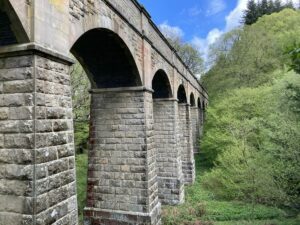We use the following resources to aid our research on industrial heritage sites.
Maps
Google Maps
Google Maps is by far one of the best map tools online. It has a satellite layer, which is very useful for topographical discoveries, for example, trying to find a path that is not visible on the default map layer.
One of the best features of the satellite layer is that it offers a 3D view of certain areas, mostly urban. In this instance, we can view the eastern flight of the Smethwick Locks with the Engine Arm Aqueduct. The detail gives us a sufficient idea of the landscape and will greatly aid our visitation planning.
Another useful feature is the street view function. You can virtually travel along most public roads at street level and better yet, a historical record of each street view is available. This means you can view what a street looked like from when Google started photographing that area. For example, we can see what the old filling hall of the Hill, Evans & Co vinegar works looked like in 2008 before it was restored.
Ordnance Survey Maps
https://maps.nls.uk/os/index.html
The National Library of Scotland has an amazing collection of old ordnance survey maps, many have been painstakingly arranged into a seamless format. That means you can scroll and zoom in and out of 19th or 20th century maps as you would with Google Maps, and there are some additional features that are very handy.
When viewing the seamless zoomable overlay layer, you can toggle a transparency slider that blends the historical map with a modern satellite view from Google Maps. This is really useful if you are pinpointing the location of a site that no longer exists, or to examine how much the landscape has changed over the years.
Another key feature that deserves recognition is the side-by-side function. Certain ordnance survey maps can be viewed alongside a satellite view from Google Maps and your cursor is mirrored. This allows you to perform side by side comparisons of the historical with the modern. This is another fantastic way to study how landscapes have changed.
Rail Map Online
https://www.railmaponline.com/UKIEMap.php
This site overlays historical railway lines over OpenStreetMap. It’s quite impressive in that all private lines and sidings are included plus historical narrow gauge railways and tramways. You can easily toggle between modern and historic railways and display station locations and line features.
https://www.railmaponline.com/Canals.php
The site also has a map for canals and navigable waterways that includes routes that were abandoned and are in the process of restoration. It contains the option to display features, which details every bridge, lock, and basin. It’s quite impressive; however, you can confuse canals and navigable rivers due to the similarity of their colours
Canal History in Maps by decade
https://canalmuseum.org.uk/history/menu-decades.htm
The London Canal Museum have produced a collection of digital canal maps that detail how the network developed decade-by-decade. The maps are quite simple; therefore, do not expect to receive the same level of detail as an old ordnance survey map or a modern digital map.
Media archives
Britain From Above
https://www.britainfromabove.org.uk/
This site contains a superb collection of aerial photographs that were taken in the first half of the 20th century. It is the definitive source to understand how buildings and infrastructure looked, something that ordnance survey maps fail to deliver. We recommend you register an account so you can zoom in and save images to your own library.
Canal & River Trust Collection
https://collections.canalrivertrust.org.uk/home
Search over 37,000 archive records in the CRT’s online catalogue, including over 22,000 historic images freely available to view.
BFI Player
https://player.bfi.org.uk/free
A free collection of landmark and archive film from the British Film Institute. There is plenty of industrial activity footage from the early 20th century onwards.
Publication archives
The Railway and Canal Historical Society Journal Archive
https://rchs.org.uk/journal-archive/
Contains every journal published by the society since 1955 except the 6 most recent issues. There is also an index of inland waterways articles.
The Association for Industrial Archaeology Past Conferences & Gazetteer Issues
https://industrial-archaeology.org/conferences/past-conferences/
A collection of notes from past conferences and previous issues of the Gazetteer.
Public bodies
Historic England
https://historicengland.org.uk/listing/the-list/map-search
Search the map to find listed buildings, scheduled monuments, protected wrecks, registered parks and gardens, and battlefields.
Coflein
https://coflein.gov.uk/en/map/
Search the map to find details of many thousands of archaeological sites, monuments, buildings and maritime sites in Wales, together with an index to the drawings, manuscripts and photographs held in the NMRW archive collections.
Historic Environment Scotland
https://hesportal.maps.arcgis.com/apps/Viewer/index.html
Search the map for listed buildings, scheduling, and designations in Scotland.

